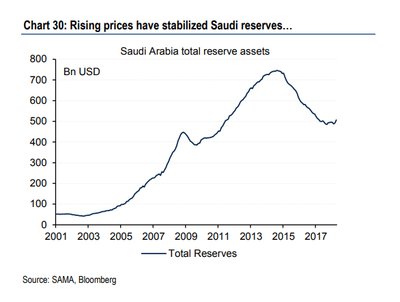Oil is now a ‘game of chicken’ and cutting off Iran could push it to $120 a barrel says Bank of America

Pic: Yuichiro Chino / Moment via Getty Images
Crude oil could surge to more than $US120 a barrel, according to Bank of America Merill Lynch analysts, if the Trump administration were to order a complete cut-off of Iranian barrels before the end of the year.
“Oil is now a game of chicken,” the analysts wrote in a note on Friday.
They said zero-tolerance sanctions on Iran – the fourth-largest oil producer – could add $US50 per barrel to crude prices, which are up more than 25 per cent this year.
That’s good news for ASX-listed oil stocks — many of which have seen which have seen gains this year.
Brent, the international benchmark, is now trading at $US77 a barrel.
The US State Department said last week that certain countries, including India and South Korea, will be allowed reduced flows of Iranian oil. And Saudi Arabia recently agreed to increase production by two million barrels per day, according to a White House statement.
But analysts are sceptical Saudi Arabia will be able to keep up. The unofficial leader of the Organisation of Petroleum Exporting countries has never pumped more than 10.6 million barrels per day on average over a single month, according to BAML.
“It appears the oil market has little confidence that Iran volumes can be easily replaced,” the analysts wrote.
The move is part of Trump’s withdrawal from the Iran nuclear deal, which previously eased economic penalties on the country as long as it curbed its nuclear weapons program.
The oil sanctions come after OPEC and other supply-cutting countries agreed at a summit in June to reduce compliance from more than 150 per cent in May to about 100% starting this month. The cartel had previously been practicing over-compliance in efforts to tackle a global oil glut.
But it is unclear if the new agreement will be able to balance supply as multiple producers – Venezuela, Libya, Angola, Mexico, or Nigeria – face major output disruptions.
“Unlike in trade wars, oil price shocks do not have winners,” the analysts wrote. “But these do not include the US, China, Europe, Japan.” Rising oil prices have stabilised Saudi Arabia’s foreign exchange reserves, they added, after a $US250 billion drop in the last three years. At the same time, other countries face higher energy prices.
Rising oil prices have stabilised Saudi Arabia’s foreign exchange reserves, they added, after a $US250 billion drop in the last three years. At the same time, other countries face higher energy prices.
The analysts estimate that every million barrel per day shift in supply and demand balances would push oil prices by $US17 a barrel on average.
Based on that assumption, they added, zero Iran exports could push oil up by $US50 a barrel if Saudi Arabia caps out.
“In this game of chicken, we expect someone will blink before that happens,” they wrote.
This article first appeared on Business Insider Australia, Australia’s most popular business news website. Read the original article. Follow Business Insider on Facebook or Twitter.
UNLOCK INSIGHTS
Discover the untold stories of emerging ASX stocks.
Daily news and expert analysis, it's free to subscribe.
By proceeding, you confirm you understand that we handle personal information in accordance with our Privacy Policy.








